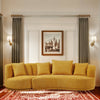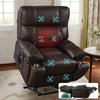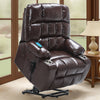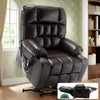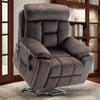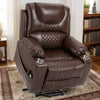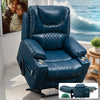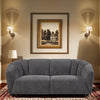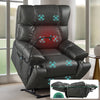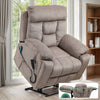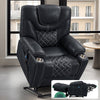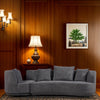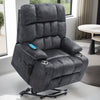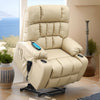The Importance of Comfort: Why Recliners are Essential for Elderly Care
Understanding the Health Benefits of Recliners for Seniors
Recliners offer many health benefits for seniors. They provide support for the back and joints. This can ease pain and improve circulation. Recliners allow seniors to change positions easily. This helps prevent pressure sores and stiffness.

Good recliners promote better sleep. They let seniors rest in a semi-upright position. This can help with breathing issues and acid reflux. Recliners also make it easier for seniors to stand up. This reduces the risk of falls and injuries.
Proper posture is crucial for seniors. Recliners help maintain good posture while sitting. This can reduce back pain and improve overall comfort. Some recliners even offer heat and massage features. These can further enhance relaxation and pain relief.
Assessing Comfort: Factors to Consider When Selecting a Recliner
When choosing a recliner for seniors, comfort is key. Look for a chair with good lumbar support. The backrest should fit the natural curve of the spine. The seat should be wide enough and have proper cushioning.
Consider the recliner's fabric. It should be soft yet durable. Breathable materials can prevent overheating. The footrest is another important factor. It should provide adequate support for the legs and feet.
The reclining mechanism matters too. It should be smooth and easy to operate. Some seniors may prefer power recliners over manual ones. The chair's size should fit the user's body type. A recliner that's too big or small can be uncomfortable.
Adjustability is crucial for personalized comfort. Look for recliners with multiple positions. This allows seniors to find their perfect angle. Some chairs offer separate back and footrest controls. This gives even more flexibility in finding a comfortable position.
Lift Recliner Chairs: The Best Choice for Elderly Comfort?
Key Features of Lift Recliner Chairs That Enhance Comfort
Lift recliner chairs offer unique features for senior comfort. The main advantage is the lift mechanism. It helps seniors stand up with less effort. This reduces strain on joints and muscles.

These chairs often have multiple reclining positions. Users can adjust from sitting to fully reclined. Some models offer 'zero gravity' positions. This helps relieve pressure on the spine and improves circulation.
Many lift recliners have built-in massage features. These can help soothe sore muscles and improve relaxation. Heat therapy is another common feature. It can provide relief for arthritis and other joint pains.
The upholstery in lift recliners is usually designed for comfort. Many use soft, plush fabrics. Some are even waterproof or stain-resistant. This makes cleaning and maintenance easier.
The Technological Advancements in Lift Recliners
Lift recliners have seen many technological improvements. Modern models often come with remote controls. These make adjusting positions easier for seniors with limited mobility.
Some lift recliners now have memory foam cushions. These conform to the body for better support. Others use gel-infused foam. This helps regulate temperature and prevent overheating.
Advanced models may include USB charging ports. Seniors can easily charge their devices while relaxing. Some chairs even have built-in speakers. This allows users to enjoy music or TV audio directly from their chair.
Smart home integration is becoming more common. Some lift recliners can be controlled via voice commands. This adds convenience for seniors who struggle with remote controls.
Safety features have also improved. Many chairs now have backup battery systems. These ensure the lift function works even during power outages. Some models have sensors. These prevent the chair from operating if obstacles are detected.
Traditional Recliners: A Time-Tested Solution for Elderly Comfort
Analyzing User Preferences: Why Seniors Choose Traditional Recliners
Traditional recliners remain popular among many seniors. They often prefer the familiar design. These chairs have a classic look that fits well in most homes. This aesthetic appeal is important to many older adults.

Simplicity is a key factor. Traditional recliners usually have straightforward controls. This can be less intimidating for seniors who aren't tech-savvy. The manual reclining mechanism is often easy to use.
Cost is another consideration. Traditional recliners are often more affordable than lift chairs. This makes them accessible to seniors on fixed incomes. They also tend to have lower maintenance costs.
Many seniors appreciate the durability of traditional recliners. These chairs are often built to last for many years. This longevity is valuable for those who don't want to replace furniture often.
Some seniors find traditional recliners more comfortable. They may prefer the feel of a classic recliner. The familiar design can provide a sense of comfort and security.
The Role of Ergonomics in Traditional Recliner Designs
Ergonomics play a crucial role in traditional recliner designs. Many models offer excellent lumbar support. This helps maintain proper spine alignment while sitting. Good lumbar support can reduce back pain and improve posture.
The seat design is carefully considered. It often includes a waterfall edge. This reduces pressure on the back of the thighs. It can improve circulation and prevent numbness.
Armrests are positioned for optimal comfort. They support the arms and shoulders. This can help reduce neck and upper back strain. Some models have adjustable armrests for personalized comfort.
The backrest angle is important in traditional recliners. It's designed to support the natural curve of the spine. Many chairs offer multiple reclining positions. This allows users to find their most comfortable angle.
Footrests are engineered for leg support. They often extend fully to promote better circulation. Some models have adjustable footrests. This accommodates different leg lengths and preferences.
Many traditional recliners now incorporate swivel bases. This allows seniors to turn easily without straining. It can be particularly helpful for those with limited mobility.
Material choice is also part of ergonomic design. Many recliners use high-density foam. This provides support while remaining comfortable. Some use memory foam for personalized comfort.







